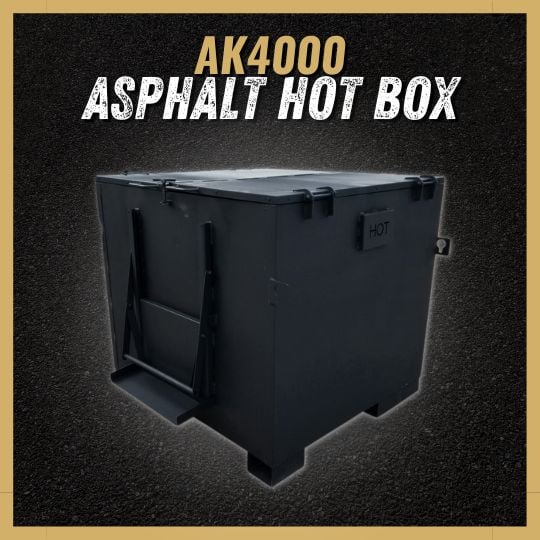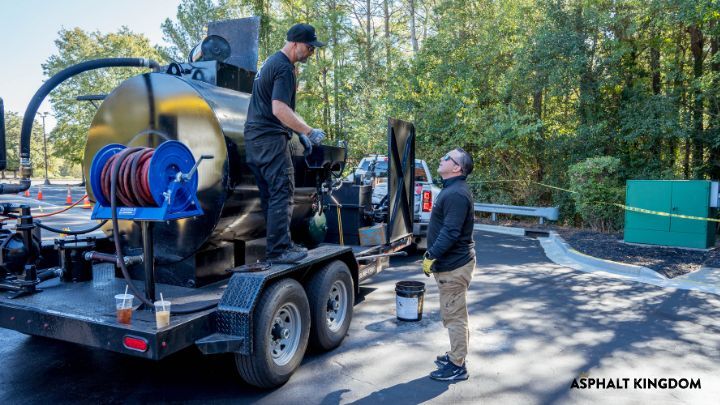Potholes. They don't just ruin parking lots and driveways. They are also a hazard to you, your family, or customers. Potholes can damage cars, injure someone, and are very costly to property owners if neglected.
That's why it's important to have them fixed now before they cause injuries or lead to lawsuits.
If you're looking for the best pothole filler materials and advice on how to fix potholes, then this blog is for you. Read on and get our expert tips below.
How do Potholes Form?
Before we discuss asphalt pothole repair products and how to use them, let's take a look at how potholes form.
Potholes start as tiny cracks that many property owners barely notice at first. If you're a property owner and you neglect to fill these cracks immediately (or you don't sealcoat your asphalt regularly), rainwater and meltwater can seep into these cracks.
All that water trickling down weakens the asphalt's base and grows into a pothole.
What is the Best Material to Fill Potholes?
There are two types of materials used as pothole filler available for property owners and DIYers:
- Cold Asphalt Patch
- Asphalt Millings
There is also hot asphalt that can be used to patch potholes, but this material is mostly only used by professional contractors because special equipment is needed to keep the asphalt hot.
Cold Asphalt Patch
Cold asphalt patch, also known as cold mix asphalt or pothole patch, is made up of aggregates of different sizes and uses asphalt emulsion as a binder. This product is designed as a quick fix and is commonly used for small-scale asphalt pothole repair.
This type of pothole patch is sold in bags or buckets and can be used right away.
Pros:
1. Ready to use right out of the container. Cold asphalt patches are sold premixed and ready to use. Just pour the mix into the pothole, tamp it down, and the section can be driven on immediately.
2. It's affordable. All you need for a fast driveway pothole filler is a bag or two of cold asphalt patch, and you're good to go. With this product, you don't need to buy an expensive piece of equipment or other asphalt repair supplies.
3. It's a great quick fix. Spotted a pothole in your driveway this morning and need to fix it before it rains or snows tomorrow? Then order a cold asphalt patch.
Cons
1. It's designed to be a temporary solution. If you're looking for something that will last longer or you're repairing a high-traffic section of your parking lot, then it's best to choose the next option.
Asphalt Millings
Also known as hot mix asphalt, asphalt millings are made of aggregates (sand, gravel and stone) and use asphalt cement as a binder. These components are mixed and heated in a hot-mix asphalt plant before being shipped to a job site. This is commonly used for permanent pothole repair.
Pros:
1. It lasts longer. Both asphalt cement and aggregates are some of the sturdiest materials on earth and mixed together they can withstand extreme wear and tear. This makes asphalt millings a great choice for pothole filler for high-traffic areas and large-scale projects.
2.The pavement can be used right away after pothole patching. If you own a grocery store or a restaurant, then you're probably looking for something that will allow you to use your parking lot or driveway right after the potholes are patched. If this is the case, then asphalt millings are your best option as the section can be used right after it's tamped down.
3. It's perfect for places that are extremely hot or cold. Hot mix asphalt is a great choice for pothole filling as it can withstand extreme heat and extreme cold.
Cons:
1. It is a little more expensive than a cold asphalt patch. Compared to cold asphalt mixes, filling potholes using hot mix asphalt is more expensive. But the good news is it can take many years before you see chipping and disintegration in the repaired area, which makes it a good investment in the long run.
2. It can only be done by a trained professional. Hot mix asphalt is applied using an infrared asphalt heater. Investing in a piece of equipment like the Mini Infrared Asphalt Heater can set an ordinary property owner back at least a couple thousand dollars or more. As a residential or commercial property owner, it's not practical at all to invest in a piece of equipment that you will only use occasionally.
So What is the Best Material to Fill Potholes?
The answer depends on several factors.
Are you looking for a product you can easily order online or from your favorite hardware store? Do you want to patch that pothole on your own? Are you looking for an easy-to-apply and affordable pothole patch? If you answered yes to those, then choose a cold asphalt patch.
But if you want a more long-lasting asphalt pothole repair solution, then hire someone to patch the pothole for you using asphalt millings and an asphalt infrared heater. It's a little more expensive than cold asphalt patch, but it saves you time and can be a more convenient choice for many property owners.
Pothole Patch Methods: 2 Ways to Fill Potholes
Pothole Patch Method 1: Cold Asphalt Patch Pothole Repair
Step 1: Prepare the pothole for patching by cleaning it thoroughly. Using a wire street broom, remove any loose aggregates, leaves, and dust from the pothole and the surrounding area.
Step 2: Pour cold asphalt patch into the pothole and spread it with a rake. Pour enough pothole patch so that it reaches up to 1/2" above the asphalt surface.
Step 3: If you're using a water-activated pothole patch like Aquaphalt 6.0 Concrete and Asphalt Patch, then this is the time to sprinkle some water on the patched area. Skip this step if the product does not need to be activated with water.
Step 4: Use a tamper tool to tamp down the patched section. Make sure the area is level to prevent the center from becoming a birdbath.
You can also drive over the area repeatedly to compact it.
Pothole Patch Method 2: Infrared Pothole Repair with Asphalt Millings
Step 1: Clean the pothole using a wire street broom or a gas leaf blower. Remove any loose rocks and debris from the area.
Step 2: Roll the Mini Infrared Asphalt Heater in place. Heat the area for about seven to ten minutes.
Step 3: Turn the machine off and remove it from the area (or heat another section, in the meantime) and shovel some asphalt millings into the pothole. Make sure to transport the millings in a high-capacity asphalt hot box to keep it at optimum temperature.
Step 4: Rework the heated area with a rake or asphalt lute. Start by pushing the edges inward (about an inch or so) before reworking the entire area with your lute.
Step 5: Spritz some asphalt millings rejuvenator onto the repaired section.
Step 6: Tamp it down using a tamper tool. You can also use a vibrating plate compactor or an asphalt roller to compact the area.
The area is ready to use right away.
Go Fix Those Potholes
Whether you're a DIYer or a pavement asset management specialist, we hope this blog has helped you find the best material to fill potholes. Shop at the Asphalt Kingdom store for Asphalt Patch Repair, Asphalt Infrared Patching, and Surface Preparation supplies and equipment.






-2.jpg)
-1.jpg)